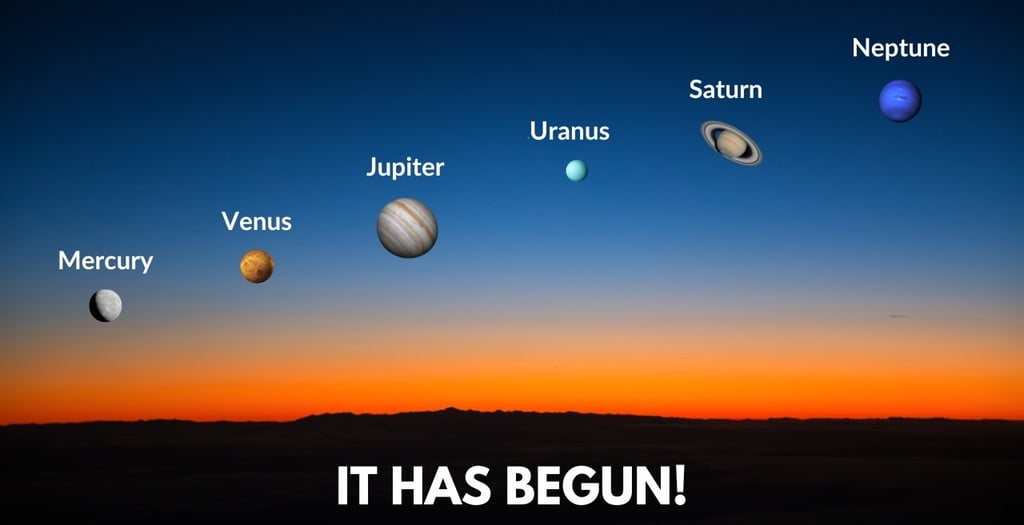Stargazing Spectacular: August 2025 Brings a 6-Planet Alignment, Venus-Jupiter Conjunction, and Perseid Meteor Shower
NEWS
8/10/20253 min read


Get ready for an unforgettable cosmic show in August 2025! Just before sunrise on August 12th, the eastern horizon will host a breathtaking alignment of six planets—Mercury, Venus, Jupiter, Uranus, Saturn, and Neptune—stretching across the morning sky. This marks the second major planetary alignment of the year, following the "Grand Planetary Alignment" that dazzled evening skies earlier in 2025. But that’s not all—August also brings a stunning Venus-Jupiter conjunction and the peak of the Perseid meteor shower, making it a prime time for stargazers. This SEO-optimized guide, inspired by The Secrets of the Universe YouTube video, covers these celestial events, key viewing dates, and tips to catch them, along with related images and alt text for accessibility.
A Rare 6-Planet Alignment: What to Expect
On the morning of August 12th, look east before sunrise to witness Mercury, Venus, Jupiter, Uranus, Saturn, and Neptune aligned across the sky. Four of these—Mercury, Venus, Jupiter, and Saturn—are visible to the naked eye, while Uranus and Neptune require binoculars or a telescope. By August 15th, Mercury rises higher, completing the six-planet parade. Unlike the earlier 2025 alignment, Mars won’t join this lineup, as it’s shining in the western sky after sunset.
Best Viewing Time: Just before sunrise, 4:00–5:30 a.m. local time, August 12–15, 2025.
Location: Eastern horizon, clearest in the Southern Hemisphere due to longer pre-dawn twilight.
Tips: Find a spot with minimal light pollution and a clear view east. For Northern Hemisphere viewers, Mercury may be tricky to spot due to early daylight.
This alignment is a rare treat, showcasing the solar system’s beauty in one sweeping view.
Venus and Jupiter’s Dazzling Conjunction
The highlight of the alignment is the close conjunction of Venus and Jupiter on August 12th. These two brightest planets will appear less than a degree apart, forming a brilliant “double star” in the dawn sky. Venus, often called the Morning Star, outshines all others, with Jupiter a close second. Their proximity will be visible even in light-polluted cities, no equipment needed.
Why It’s Special: Conjunctions of Venus and Jupiter occur nearly annually, unlike the rarer Jupiter-Saturn “Great Conjunction” every 20 years (last seen in December 2020). Their brightness makes this a must-see event.
Viewing Tip: Watch from August 10th–12th to see them draw closer each morning, peaking on August 12th when they’re side by side. Venus will be slightly brighter; Jupiter climbs higher post-conjunction.
Fun Fact: By late August, Venus sinks toward the sun’s glare, while Jupiter rises higher, shifting to evening skies by September.
Perseid Meteor Shower: A Night of Shooting Stars
On the night of August 12th, just hours after the conjunction, the Perseid meteor shower peaks, offering up to 120 meteors per hour under ideal conditions. Caused by Earth passing through debris from Comet Swift-Tuttle, the Perseids are known for fast, bright meteors, some leaving glowing trails or exploding as fireballs.
Best Viewing Time: 2:00–4:00 a.m. local time, August 12–13, 2025.
Challenges: Moonlight may wash out fainter meteors, but brighter ones will shine through, especially in rural areas with minimal light pollution.
How to Watch: No equipment needed—just lie back, let your eyes adjust to the dark for 30 minutes, and look toward the constellation Perseus (the shower’s radiant point).
September Sneak Peek: Lunar Eclipse and Saturn’s Opposition
August’s wonders set the stage for September 2025, featuring a record-breaking total lunar eclipse visible to 88% of the world’s population (Africa, Europe, Asia, Australia, parts of the Pacific) on September 7–8. Totality lasts 82 minutes, turning the moon a deep red “blood moon.” North and South America will miss this one, but a partial solar eclipse follows on September 21st in Oceania and Antarctica. That same day, Saturn reaches opposition, appearing at its brightest and closest to Earth—perfect for photography.
How to Prepare for These Celestial Events
Equipment: Naked eye for Venus, Jupiter, Saturn, Mercury, and Perseids; binoculars or a telescope for Uranus and Neptune.
Location: Choose a dark, open area away from city lights. Use apps like Stellarium to locate planets.
Weather: Check forecasts for clear skies, especially on August 12th–13th.
Stay Updated: Subscribe to The Secrets of the Universe on YouTube for detailed guides and upcoming videos on September’s events.
